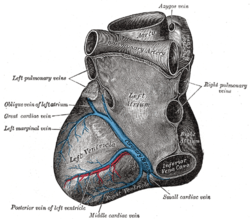Smallest cardiac veins
| Smallest cardiac veins | |
|---|---|
 | |
| Details | |
| Identifiers | |
| Latin | venae cardiacae minimae, venae cordis minimae |
| TA98 | A12.3.01.013 |
| TA2 | 4169 |
| FMA | 71568 |
| Anatomical terminology | |
The smallest cardiac veins (also known as the Thebesian veins (named for
They are most abundant in the
Structure
The smallest cardiac veins vary greatly in size and number. Those draining the right atrium have a lumen of up to 2 mm in diameter, whereas those draining the right ventricle have lumens as small as 0.5 mm in diameter.[5]
Course
They run a perpendicular course to the endocardial surface, directly connecting the heart chambers to the medium-sized, and larger coronary veins.[6]
Openings
The openings of the smallest cardiac veins are located in the
Function
The small cardiac veins are responsible for venous return of 10% of the coronary blood supply.
History
Etymology
The smallest cardiac veins are also known as the Thebesian veins.
Mislabelling
The smallest cardiac veins are sometimes accurately referred to as vessels, but they are frequently confused with a distinct set of artery connections,[12][13][14][15] eponymously referred to as the "vessels of Wearn".[16] In his 1928 publication, Wearn himself referred to the arterio-cameral connections (vessels of Wearn) as Thebesian,[17] but later, after additional research, provided disambiguation and strictly used the term Thebesian for coronary vein-heart chamber connections.[18]
References
- PMID 14246341.
- ISBN 978-0-7817-7055-2. Retrieved 31 October 2010.
- PMID 32491498, retrieved 2023-01-05
- ^ "Venae cordis minimae". radiopaedia.org. Retrieved 31 August 2019.
- OCLC 1201341621.)
{{cite book}}: CS1 maint: location missing publisher (link - .
- PMID 32491498, retrieved 2023-01-05
- PMID 18703466.
- PMID 19901354.
- Who Named It?
- ^ Thebesius, AC (1708). Disputatio medica inauguralis de circulo sanguinis in corde. Doctoral dissertation, Leiden.
- PMID 27743821.
- S2CID 40212007.
- PMID 19312228.
- .
- PMID 26139649.
- PMID 19869414.
- .
